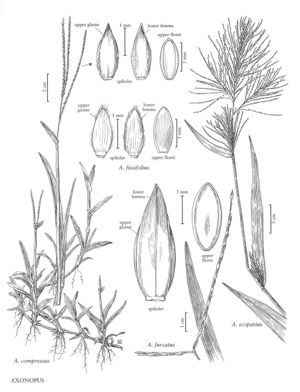Difference between revisions of "Axonopus furcatus"
FNA>Volume Importer |
imported>Volume Importer |
||
| (4 intermediate revisions by 2 users not shown) | |||
| Line 4: | Line 4: | ||
|publications= | |publications= | ||
|common_names=Big carpetgrass | |common_names=Big carpetgrass | ||
| + | |special_status={{Treatment/ID/Special_status | ||
| + | |code=E | ||
| + | |label=Endemic | ||
| + | }} | ||
|basionyms= | |basionyms= | ||
|synonyms= | |synonyms= | ||
| Line 17: | Line 21: | ||
-->{{Treatment/Body | -->{{Treatment/Body | ||
|distribution=Md.;Del.;Miss.;Tex.;La.;Ala.;N.C.;S.C.;Va.;Ark.;Ga.;Okla.;Fla. | |distribution=Md.;Del.;Miss.;Tex.;La.;Ala.;N.C.;S.C.;Va.;Ark.;Ga.;Okla.;Fla. | ||
| − | |discussion=<p>Axonopus furcatus is endemic to the southeastern United States. It grows in moist pine barrens, marshes, river banks, wet ditches, pond margins, and other such damp areas.</p> | + | |discussion=<p><i>Axonopus furcatus</i> is endemic to the southeastern United States. It grows in moist pine barrens, marshes, river banks, wet ditches, pond margins, and other such damp areas.</p> |
|tables= | |tables= | ||
|references= | |references= | ||
| Line 26: | Line 30: | ||
-->{{#Taxon: | -->{{#Taxon: | ||
name=Axonopus furcatus | name=Axonopus furcatus | ||
| − | |||
|authority=(Flüggé) Hitchc. | |authority=(Flüggé) Hitchc. | ||
|rank=species | |rank=species | ||
| Line 33: | Line 36: | ||
|basionyms= | |basionyms= | ||
|family=Poaceae | |family=Poaceae | ||
| − | |illustrator=Linda A. Vorobik | + | |illustrator=Linda A. Vorobik;Karen Klitz |
| + | |illustration copyright=Utah State University | ||
|distribution=Md.;Del.;Miss.;Tex.;La.;Ala.;N.C.;S.C.;Va.;Ark.;Ga.;Okla.;Fla. | |distribution=Md.;Del.;Miss.;Tex.;La.;Ala.;N.C.;S.C.;Va.;Ark.;Ga.;Okla.;Fla. | ||
|reference=None | |reference=None | ||
|publication title= | |publication title= | ||
|publication year= | |publication year= | ||
| − | |special status= | + | |special status=Endemic |
| − | |source xml=https:// | + | |source xml=https://bitbucket.org/aafc-mbb/fna-data-curation/src/200273ad09963decb8fc72550212de541d86569d/coarse_grained_fna_xml/V25/V25_1439.xml |
|subfamily=Poaceae subfam. Panicoideae | |subfamily=Poaceae subfam. Panicoideae | ||
|tribe=Poaceae tribe Paniceae | |tribe=Poaceae tribe Paniceae | ||
Latest revision as of 18:57, 11 May 2021
Plants stoloniferous. Culms 30-100 cm; nodes glabrous or pubescent. Sheaths compressed, glabrous or sparsely to densely pilose, hairs appressed; ligules 0.3-1 mm; blades 3-25 cm long, 2-15 mm wide, margins often with papillose-based hairs near the base, scabrous distally. Panicles terminal and axillary, with 2 (-4) divergent branches; branches 4-15 cm. Spikelets 3.5-5.5 mm long, about 1.5 mm wide, sessile or subsessile, ovoid-ellipsoid, acuminate. Upper glumes glabrous, 5-7-veined; lower lemmas 5-7-veined, glabrous or sparsely pilose over the veins; upper lemmas and paleas 2.5-3.2 mm, light yellow, obtuse. Caryopses 1.8-2.2 mm, obovate, yellow. 2n = unknown.
Distribution
Md., Del., Miss., Tex., La., Ala., N.C., S.C., Va., Ark., Ga., Okla., Fla.
Discussion
Axonopus furcatus is endemic to the southeastern United States. It grows in moist pine barrens, marshes, river banks, wet ditches, pond margins, and other such damp areas.
Selected References
None.
